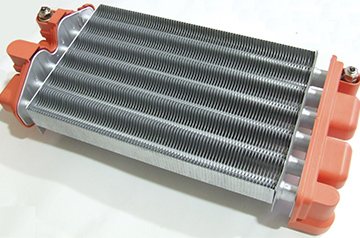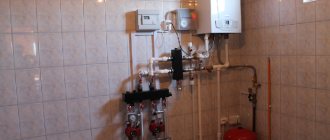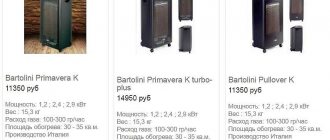Purpose, types of metal heat exchangers
The design and performance of heating devices depend on the purpose, principle of operation, and material of the heat exchanger. For example, it is impossible to create a compact cast iron product for a parapet or wall heater. Since carbon steel or cast iron has a significant density, and hence mass. Old cast iron boilers are a thing of the past. Small-sized heating structures with lightweight parts and a higher level of energy transfer are popular today. These include gas wall-hung boilers with a copper heat exchanger.
In the production of a thermodynamic structure, materials such as are used: • copper; • steel of different grades; • cast iron; • aluminum; • silumin.

In modern domestic heating boilers, a heat exchange unit occupies most of its surface. The economic and environmental parameters of the boiler depend on the design and type of material.
Heat exchangers are classified depending on the purpose for such types as heating, cooling, condensing, evaporating. According to the principle of operation, the blocks are regenerative, recuperative and mixing. The first two types have the general name "thermal surface apparatus". One example of such units is radiators in cars. Their purpose is to participate in the operation of the engine cooling system. The heated water comes into contact with air through the walls of the copper-aluminum heat exchangers.
In mixing (contact) machines, two working streams (hot and cold) are mixed with each other. A similar process is observed in jet condensers, where the sprayed liquid uses the condensation energy. They are easier to manufacture and have a higher heat capacity. But the scope is limited.


DIY air plate heat exchanger assembly with fan
Let's make a household heater from a plate heat exchanger. It can, for example, be connected to a water-jacketed boiler.


- finished plate heat exchanger, small size;
- duct connections;
- fan;
- plywood for assembling the frame (its dimensions must match the dimensions of the side walls of the heat exchanger) - 4 pcs;
- plywood for the front of the frame - 1 pc;
- Metal sheet;
- a bar (long enough for a frame and 4 short bars);
- self-tapping screws;
- roulette;
- jigsaw;
- screwdriver.
- A box is knocked out of pieces of plywood. Internal corners are fixed with self-tapping bars. The heat exchanger must fit tightly into the frame.
- We attach a sheet of metal to one side of the frame, cut a hole in the middle into which the fan will be inserted.
- We make a frame from a bar. We fix it on the opposite side of the frame.
- Air outlet pipes are attached to the frame.
Heating devices made of steel and copper alloys
Since the mass production of household appliances is focused on the manufacture of heat exchangers from ferrous metal, gas boilers with a copper heat exchanger are considered a prestigious product. Copper has high heat transfer characteristics. Therefore, small boilers with a small amount of heat carrier can be used to heat a large house. As a result, the devices are very compact.
Important! Often, buyers are interested in which heat exchanger to choose - steel or copper. You need to proceed from the physical and chemical properties of ferrous and non-ferrous metals. The specific heat capacity of copper is lower than that of steel.
That is, to heat an equal amount of substance, copper needs to transfer less heat than steel. Accordingly, the inertia of the heating system, where there is a steel heat transfer unit, is greater. The boiler automation, working with a copper heat transfer block, reacts faster to an increase in the temperature of the coolant. As a result, this leads to fuel savings. An even greater reaction of the heating system to heating occurs when the pump is running. In addition, it provides improved circulation even with disturbed pipe slopes and prevents water from boiling.


Comparing copper heat exchangers for boilers with steel, we can say that the latter are more plastic. This factor is important because there is a constant process of interaction with open fire. As a result, thermal stresses in the metal develop and cracks appear. Steel is more durable in this respect and withstands a large number of cycles: heating - cooling.
The note! The disadvantages of steel, in addition to inertia, increased specific heat capacity, include: • susceptibility to corrosion; • increased volume of the air heater surface; • a large amount of coolant; • a significant mass of heating devices.
Which gas boiler is better: steel or cast iron?
When you urgently need to heat a rural house, it is better to use proven gas boilers, which firmly guarantee a high level of heat output with low fuel consumption. But gas boilers, widely available on the market, are found not only from classic gray cast iron, but also from steel. But which option is considered preferable a priori?


If we take into account the resource of operation, it is better to purchase cast-iron gas boilers, which in our realities have become practically living classics. Indeed, due to the presence of an excess percentage of carbon (2%) in cast iron, cast iron tends to corrode extremely slowly.
Considering the fact that in the private sector a high-quality coolant is mainly used in the form of ordinary soft water without the addition of salts or phosphates, in real practice one can safely expect that a cast-iron gas boiler from the best manufacturers can really last up to 50 years without corrosion and repair.


Cast iron is also distinguished by its repairability. If a fistula appears somewhere, then everything can be welded with ordinary gas welding. By the way, this is what most of the sellers of gas heating equipment do - they assemble most of the cast iron gas boilers using acetylene welding right at the customer's site, which allows you to bring compact monoblocks in advance and then weld a one-piece gas boiler of any capacity! Medium power boilers (up to 20 kW), as a rule, are manufactured by manufacturers in a ready-made form, which allows the buyer to buy them, bring them to his home, quickly install and immediately start using them.
But steel boilers also have their advantages - they are distinguished by higher thermal conductivity, low weight and a democratic price, thanks to which most of the homeowners can afford them. In steel boilers, not only the inner walls are made of stainless steel, but even the heat exchanger, due to which the coolant tends to heat up much faster, and the boiler itself will begin to consume a minimum of gas, which in reality allows a steel boiler to pay off in just a couple of heating seasons!
Steel boilers are extremely lightweight. For example, if we take into account a floor-standing cast-iron boiler with a capacity of 17 kW, then its weight will be about 180 kg, which will require a separate concrete floor screed in the utility room. But if you buy a steel boiler, then its weight with the same power will be 3-4 times less, which will allow you to use any weaker floor both in a residential and utility room.The service life of steel boilers is slightly less than that of cast iron (on average, no more than 15 years), but if we take into account their high fuel efficiency and low price, then the purchase of this heating equipment for a household will initially be a profitable financial and practical solution.
Gas water heater with copper heat exchanger
The gas column contains a heat exchanger, in which water is heated by a burner. Copper with a high heat transfer coefficient quickly transfers heat to the water, which is used for taking a bath. The less impurities in the alloy are, the better, copper products work. If they are present, the walls of the container heat up unevenly, which causes them to burn out quickly. Sometimes, in order to lower the price of a copper heat exchanger, the wall thickness and tube diameter are reduced. The weight of the empty apparatus is up to 3.5 kg.
The heat exchange unit is manufactured in the form of a tube. In the lower part, it has the shape of a snake with ribs. A metal sheet is installed around it, and on top of it is a spiral pipe. In addition to copper, galvanized and stainless steel is used. Which heat exchanger is better, copper or stainless steel, says the very fact of the cost of the device. Copper is 20 times more expensive than steel alloy. But it transfers heat better and is more economical in operation. Stainless steel is more durable.


Important! Before buying a gas water heater with a copper heat exchanger, you should study its technical parameters. A good thing won't come cheap. Copper oxidizes strongly upon contact with water. This process is especially observed in the place where cold water is supplied. Condensation forms there. High humidity eats away at the tube wall and fistulas appear. They form quickly on thin walls. Quality goods will last the due time.
System design
So, the purpose of the device is to transfer temperature from one environment to another. Various liquids, gases and steam can be sources of heat and heat carriers. Unstable media are separated by a material that has a suitable thermal conductivity index for this. The simplest example of a heat exchanger is a conventional room radiator. The heat source is water in heating. The heated medium is the air in the room. And the separating material is the metal from which the radiator is made.
An important role in which intermediate material to use is played by its degree of thermal conductivity. The leaders in this indicator are silver and copper. But for obvious reasons, copper is most often used.


Copper transfers heat 7.5 times better than steel, and plastic is 200 times worse than steel. It turns out that, all other things being equal, 1.7 meters of copper, 12 meters of steel and 2000 meters of plastic pipes will transfer the same amount of heat.
By designation, heat exchangers are divided into:
The former contain a cold gas or liquid. Contacting with it, the heated coolant cools down.
Heaters, on the contrary, contain a heated gas (liquid), which shares heat with the circulating cold liquid (gas).


Surface heat exchanger device
Both "heaters" and "coolers" can differ in design:
- Surface (the case when the media are in contact through the intermediate surface).
- Regenerative (alternate supply of cold and hot media to a special nozzle, which, by heating and cooling, regulates the temperature of the media).
- Mixing (feeding one medium directly into another and mixing them).
I must say that surface heat exchangers are used most often. They differ significantly in shape. Three types can be distinguished here:
- Lamellar (many plates, collected in cassettes, through the labyrinths of which the liquid passes).
- Coils (thin tube twisted into a spiral).
- A pipe in a pipe.
Dual fuel heating can be very convenient, especially when there is an interruption to one of the heating sources. Combined heating boilers have two combustion chambers and are produced in different versions: gas - electricity, gas - coal and so on. We will consider the design of the system and methods of installation below.
We will consider the features of choosing a thermostat for a heating radiator here.
The usual heating methods can be inconvenient in some situations. Heating without gas or wood can be a good alternative. Here https://microklimat.pro/sistemy-otopleniya/bez-gaza-i-drov.html, consider how to organize heating a room without using firewood and gas.
Repair of copper heat exchangers
During the operation of evaporators, different types of damage appear: • breaks in pipes at the point of water supply and its outlet; • violation of integrity as a result of water hammer; • dents, fistulas; • violation of the tightness of threaded connections.
Before starting the repair, a search is performed for microcracks that are not visually noticeable. Hidden defects can only be detected by crimping. Fistulas are removed by brazing the copper heat exchanger using high temperature solders.


For work you need a soldering iron, flux and solder. First, a flux is applied, which cleans the surface of oxidized particles. It also helps to distribute the solder evenly. A paste that contains copper is used as a flux. If it is not there, then you can take rosin and even an aspirin tablet.
The note! When welding a copper heat exchanger, it is necessary that the solder melts from the tube, and not from contact with the soldering iron.
The solder layer in the damaged area builds up gradually until its thickness reaches 1-2 mm. The burner flame must be medium, otherwise the evaporator can be damaged further. After the end of the soldering, you need to remove the remaining flux. Because the acid it contains corrodes copper.
Making a pipe-in-pipe heat exchanger with your own hands
How it works, pros and cons
As the name suggests, the heat exchanger is a large tube with a smaller tube inside. The cooling or heating medium moves through the inner pipe, and the liquid to be cooled is supplied to the outer one.
A heat exchanger from a pipe can consist of several units connected in series.


This simple design has the following advantages:
- suitable for any heat carrier;
- easy to make yourself;
- easy to clean;
- serves for a long time;
- suitable for work under pressure (as opposed to plate);
- you can choose the speed of movement of fluids by changing the size of the pipes.
However, everything needs to be carefully calculated, and pipes can be quite expensive.
Manufacturing
- Tubes of different diameters (preferably copper) - 2 pcs.
- Tees T-shaped (diameter is the same as that of the larger tube) - 2 pcs.
- Short tubes of equal length, diameter = tee outlet. - 2 pcs.
- Welding and electrodes, or a powerful soldering iron and solder for copper.
- Bulgarian.
- Roulette.
We will use thin-walled copper tubes. We choose segments that are suitable in length so that the diameter of one is at least 4 mm larger than the other (the gap will be 2 mm on each side).
- Weld tees on both sides of the outer tube (side).
- We insert a tube of a smaller diameter inside and, boiling the ends of the larger tube, fix the inner tube in it.
- We weld short tubes to the outputs of the T-shaped tees, through which the liquid will come.
- If steel, rather than copper, was used, its effectiveness will be significantly lower. It makes sense to increase the working surface area by making a battery from separate heat exchangers. They are connected in series with small pieces of pipes welded to one or the other tee. The result should be a snake.
What to do with the power regulator?


A small, inexpensive device will significantly save money and help you set the temperature on the heat exchanger to your desired temperature.
To install it on the heat exchanger tube, you need to connect the thermostat with the terminals, and then the power wires.
You can avoid unnecessary work by purchasing a regulator with a built-in heating device. There will be no tangible difference in price.
The heat exchanger can be an excellent addition to the oven, it will increase its efficiency. It can be installed on ventilation holes and heat the air passing into the house, provide the house with hot water, make a conventional stove give off more heat, and much more.
A stove in the country is not a superfluous design, since the weather can be unpredictable in the off-season. Do-it-yourself brick oven for a summer residence: types of ovens, the right choice of place, recommendations for work.
Read about how to correctly calculate the power of a heating boiler in this article.
















